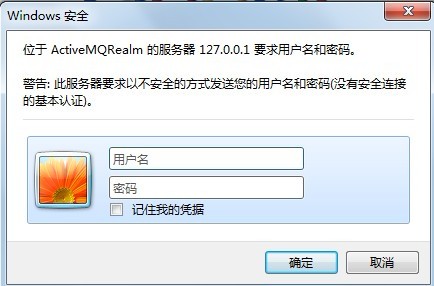前言:activeMQ分为2个安全配置。一个是web控制台的安全配置;另外一个是对于队列/主题的访问安全配置。
1.控制台安全配置
ActiveMQ使用的是jetty服务器, 打开conf/jetty.xml文件,找到
<bean id="securityConstraint" class="org.eclipse.jetty.http.security.Constraint">
<property name="name" value="BASIC" />
<property name="roles" value="admin" />
<property name="authenticate" value="false" />
</bean> 控制台的登录用户名密码保存在 conf/jetty-realm.properties文件中,内容如下:
## ---------------------------------------------------------------------------
## Licensed to the Apache Software Foundation (ASF) under one or more
## contributor license agreements. See the NOTICE file distributed with
## this work for additional information regarding copyright ownership.
## The ASF licenses this file to You under the Apache License, Version 2.0
## (the "License"); you may not use this file except in compliance with
## the License. You may obtain a copy of the License at
##
## http://www.apache.org/licenses/LICENSE-2.0
##
## Unless required by applicable law or agreed to in writing, software
## distributed under the License is distributed on an "AS IS" BASIS,
## WITHOUT WARRANTIES OR CONDITIONS OF ANY KIND, either express or implied.
## See the License for the specific language governing permissions and
## limitations under the License.
## ---------------------------------------------------------------------------
# Defines users that can access the web (console, demo, etc.)
# username: password [,rolename ...]
admin: admin, admin 重启,访问 http://127.0.0.1:8161/admin/ 将弹出:

要求输入用户名密码
2.对于JMS的安全配置
对于JMS的安全配置这里又介绍两种。现在先介绍关于“角色/权限”的一个介绍
Authorization
In ActiveMQ we use a number of operations which you can associate with user roles and either individual queues or topics or you can use wildcards to attach to hierarchies of topics and queues.
| Operation | Description |
|---|---|
| read | You can browse and consume from the destination |
| write | You can send messages to the destination |
| admin | You can lazily create the destination if it does not yet exist. This allows you fine grained control over which new destinations can be dynamically created in what part of the queue/topic hierarchy |
以上是apache官网的描述.这里稍微解释下.
其实对于队列/主题的访问只有3个操作类型,read和write我就不解释了.而admin是什么呢?这是我们在写我们自己客户端程序访问activeMQ时候,如果队列/主题不存在.则admin就可指定该"角色"是否有权限建立这个队列(没错,不像weblogic的jms那样,队列/主题没有从后台建立,则客户端无法访问.)
2.1Simple Authentication(简单的身份验证)
在conf/activemq.xml文件中加入以下内容即可(如配置了systemUsage,应该放到systemUsage前):
<plugins> <!-- Configure authentication; Username, passwords and groups --> <simpleAuthenticationPlugin> <users> <authenticationUser username="system" password="${activemq.password}" groups="users,admins"/> <authenticationUser username="user" password="${guest.password}" groups="users"/> <authenticationUser username="guest" password="${guest.password}" groups="guests"/> </users> </simpleAuthenticationPlugin> </plugins>
以上占位引用可在 conf/credential.properties中配置
2.2 JAAS身份验证
a)在conf/activemq.xml文件中加上
在配置中 ">" 代表所有的意思. 而 "ActiveMQ.Advisory.>" 则代表.名为 "ActiveMQ.Advisory."下的所有.<plugins> <!--use JAAS to authenticate using the login.config file on the classpath to configure JAAS --> <jaasAuthenticationPlugin configuration="activemq-domain" /> <!-- lets configure a destination based authorization mechanism --> <authorizationPlugin> <map> <authorizationMap> <authorizationEntries> <!-->表示通配符,例如USERS.>表示以USERS.开头的主题,>表示所有主题,read表示读的权限,write表示写的权限,admin表示角色组--> <authorizationEntry queue=">" read="admins" write="admins" admin="admins" /> <authorizationEntry topic=">" read="admins" write="admins" admin="admins" /> <authorizationEntry queue="ActiveMQ.Advisory.>" read="admins" write="admins" admin="admins" /> <authorizationEntry topic="ActiveMQ.Advisory.>" read="admins" write="admins" admin="admins" /> </authorizationEntries> </authorizationMap> </map> </authorizationPlugin> </plugins>
b)在conf目录下增加login.config,groups.properties,users.properties
login.config 内容如下:
activemq-domain { org.apache.activemq.jaas.PropertiesLoginModule required debug=true org.apache.activemq.jaas.properties.user="users.properties" org.apache.activemq.jaas.properties.group="groups.properties"; };
groups.properties 内容如下:
#group=userName admins=system
users.properties 内容如下:
#userName=password system=manager
以上两种配置方式到conf下 activemq-security.xml文件都能看到,看样子这个就是配置安全的配置文件.
最后,附上官网的配置连接:http://activemq.apache.org/security.html


























 135
135

 被折叠的 条评论
为什么被折叠?
被折叠的 条评论
为什么被折叠?








